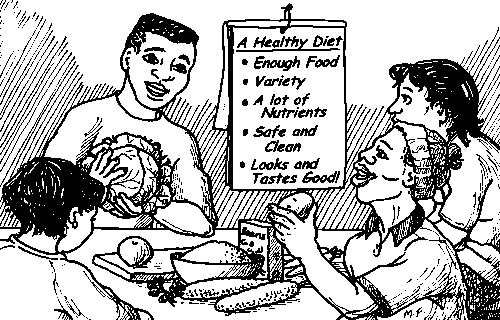
This Handbook has been developed as a part of the Rural Youth Development Programme of the Namibian Ministry of Higher Education, Training and Employment Creation.[1] This book is to enable rural youth leaders and Extension Technicians to help other young people in their villages to understand the importance of nutrition and of selecting foods which are best for health.
One of the greatest challenges faced by Namibia today is to educate the population - especially the young rural people below the age of 30 who are the majority of the Namibian population - about how to improve both the quantity and quality of the food they eat. According to the Namibian Ministry of Health and Social Services, many Namibians eat diets that are boring and do not have enough foods that give energy, vitamins and minerals. In this Handbook, the word 'diet' refers to all the food and liquids consumed by a person. An increasingly large number of Namibians eat too many foods with a lot of fat and sugar. These people are also considered malnourished because they suffer from obesity (very fat) and diet-related diseases such as diabetes, hypertension (high blood pressure) and heart disease.
In spite of poverty and a shortage of certain foods, it is still possible for Namibians to develop healthier eating habits. By learning to choose better foods, including a greater use of veld (wild) foods, our youth can change their lifestyles so that they will have more productive and enjoyable lives.
The Food & Nutrition Guidelines for Namibia[2] and the Food Guide Poster were used to decide what is most important to teach about food and nutrition when developing this Handbook. This Handbook is only the beginning of what can and should be developed to help Rural Youth leaders teach about food and nutrition.
After this Handbook has been used for a while and if the different learning activities presented in this guide had good results, additional learning activities should be developed to teach about many of the additional food and nutrition topics that are very important in Namibia.
Teaching and Learning Approach
The Teaching and Learning Approach used in this book has two major characteristics: (1) activities in which participants learn by experience, and (2) an emphasis on both project skills and life skills. Each of these characteristics is described further in the paragraphs below.
Experiential learning. Many studies have shown that most people learn best if they are active in the learning process. That means that instead of sitting in a chair or at a desk with someone telling us about what we should learn, it is better if we:
get involved in an activity
think about what we did in it and decide what was useful or important to remember from the activity
then use what we learned to perform another activity.
The name for this learning process is "experiential learning" and this Handbook contains experiential learning activities. For each activity, information about food and nutrition is also given in such a way that youth leaders can answer questions and/or add or build on what their group members learn from the activity.
Life Skills. Another important characteristic of the learning activities contained in this Handbook is that the activities not only help young people to learn about food and nutrition, but also they teach them life skills. These are useful to us now and in the future as we develop ourselves personally and contribute to the development of our families and communities. Listed below are the life skills that we can expect to be developed among youth who take part in the Rural Youth Development Programme:
Competency
Acquiring knowledge
Using scientific methods
Making career decisions
Managing resources
Communicating
Coping
Recognising self-worth
Relating to and working with others
Making decisions
Solving problems
Dealing with change
Contributing
Applying leadership skills
Taking community action
Volunteering
Conserving the environment

Both women and men should become volunteer leaders to help other young women and men to learn about how to improve their own nutrition as well as that of their families and their communities.
|
[1] In collaboration with the
Food and Agriculture Organization of the United Nations (FAO) under the
Technical Co-operation Programme Training Youth for Sustainable Livelihoods
in Rural Namibia TCP/NAM/0066(T) [2] Prepared under the auspices of the National Food Security and Nutrition Council, 2000, and published by the Ministry of Health and Social Services, Windhoek, Namibia, 2000. |